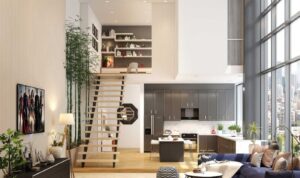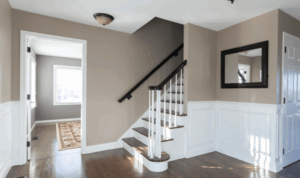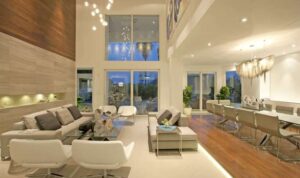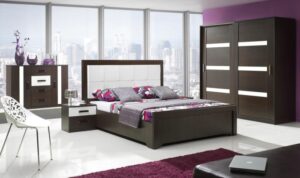Embark on a journey into the world of inside house design, where creativity meets functionality to transform living spaces. This guide offers a deep dive into the key elements and styles that shape interior design, promising a captivating exploration for design enthusiasts and novices alike.
Delve into the realm of color schemes, furniture selection, spatial arrangement, and much more as we uncover the secrets to creating a harmonious and aesthetically pleasing home environment.
Understanding Interior Design

Interior design is the art and science of enhancing the interior of a space to achieve a more aesthetically pleasing and functional environment. It involves a combination of creativity, technical knowledge, and problem-solving skills to create spaces that meet the needs and preferences of the occupants.
Interior design plays a significant role in transforming living spaces into comfortable, efficient, and visually appealing areas.
Key Elements of Interior Design
Interior designers are responsible for integrating various elements to create harmonious interiors that reflect the client's style and vision. Some of the key elements of interior design include:
- Color Schemes: The selection of colors can drastically impact the mood and atmosphere of a room. Interior designers carefully choose color palettes to create the desired ambiance.
- Furniture Selection: Choosing the right furniture pieces is crucial for both functionality and aesthetics. Interior designers consider the size, style, and placement of furniture to optimize the space.
- Lighting: Lighting plays a crucial role in highlighting design elements and creating the right ambiance. Interior designers use a combination of natural and artificial lighting to enhance the space.
- Spatial Arrangement: The layout and organization of furniture, decor, and other elements within a space are essential for creating a functional and visually appealing interior. Interior designers strategically plan the spatial arrangement to maximize usability and flow.
Interior Design Styles
When it comes to interior design, there are various styles that can help you create the perfect ambiance in your home. From modern and minimalist to traditional and contemporary, each style has its own unique characteristics that can be incorporated into different rooms within a house.
Modern Style
The modern style is characterized by clean lines, simple color palettes, and a focus on functionality. This style often incorporates materials like glass, metal, and concrete to create a sleek and sophisticated look. In a modern living room, you might see neutral colors like white, black, and grey, paired with bold accent pieces for a pop of color.
Minimalist Style
Minimalist design focuses on simplicity and creating a sense of calm and tranquility. This style typically features a neutral color palette, with an emphasis on clean, uncluttered spaces. In a minimalist bedroom, you might see a simple bed frame with crisp white bedding and minimal decor to create a serene atmosphere.
Traditional Style
Traditional design is classic and timeless, often incorporating rich colors, intricate patterns, and ornate furniture pieces. This style is all about creating a warm and inviting space, with a focus on comfort and elegance. In a traditional dining room, you might see a large wooden table with upholstered chairs and a beautiful chandelier to set the mood.
Contemporary Style
Contemporary design is constantly evolving and incorporates elements from various styles to create a fresh and current look. This style often features a mix of textures, colors, and materials to add interest and depth to a space. In a contemporary kitchen, you might see sleek cabinets, stainless steel appliances, and a pop of color on the backsplash for a modern touch.
Space Planning and Layout
Space planning is a crucial aspect of interior design that involves optimizing the functionality and flow within a house. By strategically arranging furniture, room dividers, and storage solutions, you can maximize space and create a harmonious living environment.
Optimizing Room Layouts
- Start by assessing the purpose of the room to determine the essential elements it needs.
- Consider the traffic flow within the room and ensure there is enough space for movement.
- Place furniture in a way that promotes conversation and allows for easy access to commonly used items.
- Utilize room dividers such as shelves or screens to create separate zones within an open space.
Utilizing Furniture Placement
- Choose appropriately sized furniture that fits the scale of the room.
- Avoid blocking pathways or windows with furniture placement.
- Create a focal point in each room to anchor the layout and draw attention.
Maximizing Storage Solutions
- Opt for multi-functional furniture pieces that offer storage options, such as ottomans with hidden compartments.
- Utilize vertical space with tall shelves or cabinets to free up floor space.
- Consider built-in storage solutions like wall-mounted shelves or under-bed storage to maximize space in smaller rooms.
Color and Lighting in Interior Design
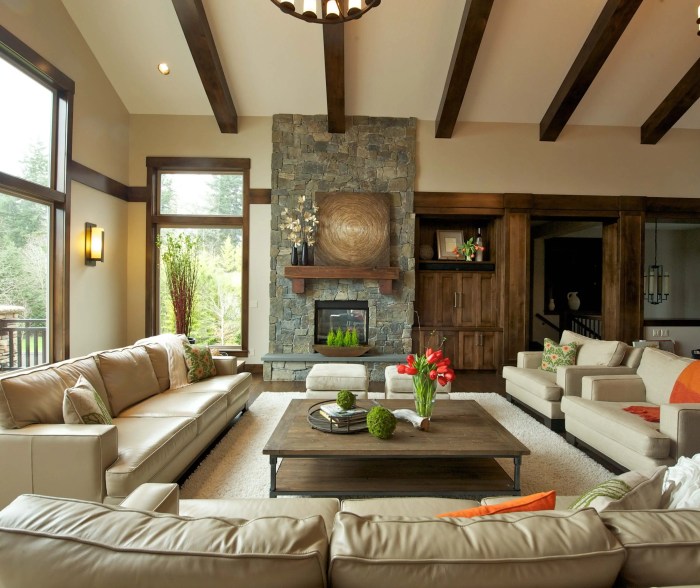
Color and lighting play crucial roles in interior design, significantly impacting the overall look and feel of a space. The choice of colors can evoke various emotions and set the mood, while proper lighting can enhance both the ambiance and functionality of a room.
Color Psychology in Interior Design
Color psychology is the study of how different colors can affect human behavior and emotions
- Red: Stimulating, passionate, and energetic. Ideal for spaces where socialization and activity are encouraged, like dining areas or living rooms.
- Blue: Calm, tranquil, and relaxing. Great for bedrooms or bathrooms where a sense of peace and serenity is desired.
- Yellow: Cheerful, optimistic, and vibrant. Perfect for kitchens or home offices to promote creativity and positivity.
- Green: Refreshing, harmonious, and natural. Suitable for areas that aim to bring the outdoors in, such as living rooms or balconies.
Importance of Lighting in Interior Design
Lighting is essential in interior design as it not only illuminates a space but also enhances its overall aesthetics. Proper lighting can highlight architectural features, create focal points, and improve the functionality of different areas. Here are some key points to consider:
- Natural light: Maximizing natural light can make a space feel brighter, larger, and more inviting. Consider using sheer curtains or blinds to allow sunlight to filter through.
- Task lighting: Task lighting, such as table lamps or under-cabinet lights, is essential for specific activities like reading, cooking, or working. It helps prevent eye strain and improves productivity.
- Ambient lighting: Ambient lighting provides overall illumination and sets the mood of a room. Consider using dimmer switches or layered lighting to create different atmospheres for various occasions.
Choosing Color Schemes and Lighting Fixtures
When selecting color schemes and lighting fixtures for different areas of the house, it's essential to consider the function of the space and the desired mood. Here are some tips to help you choose the right combinations:
- For intimate spaces like bedrooms, opt for calming colors like soft blues, greens, or neutrals. Use warm, dimmable lighting to create a cozy ambiance.
- In areas meant for social gatherings, such as the living room or dining area, consider using bold colors like reds or oranges to stimulate conversation. Incorporate a mix of overhead lighting and table lamps for flexibility.
- For workspaces like home offices, choose energizing colors like yellows or greens to boost productivity. Ensure adequate task lighting, such as adjustable desk lamps or overhead lights, to minimize glare and shadows.
Materials and Textures
When it comes to interior design, materials and textures play a crucial role in defining the look and feel of a space. From flooring to walls to furniture, the choice of materials and textures can significantly impact the overall aesthetic of a room.
Common Materials and Textures
- Wood: A versatile material that adds warmth and natural beauty to any space. It can be used for flooring, furniture, and even wall paneling.
- Stone: Durable and elegant, stone is often used for countertops, flooring, and feature walls to add a touch of luxury.
- Glass: Reflective and modern, glass is commonly used for windows, doors, and decorative accents to create a sense of openness and light.
- Textiles: Fabrics like velvet, linen, and wool can be used for upholstery, drapery, and throw pillows to add softness and comfort.
Role of Textures in Interior Design
Textures play a crucial role in interior design by adding depth, visual interest, and tactile appeal to a room. By combining different textures, you can create a multi-dimensional space that is visually engaging and inviting.
Mixing and Matching Materials and Textures
- Balance: Mix rough textures with smooth ones to create a harmonious balance in the space.
- Contrast: Play with contrasting textures like pairing a sleek glass table with a plush velvet sofa for added interest.
- Layering: Layering different textures like a shaggy rug on a hardwood floor can add dimension and coziness to a room.
- Color Palette: Consider the color palette of materials and textures to ensure they complement each other and create a cohesive look.
Epilogue
In conclusion, inside house design is a blend of artistry and practicality, where every element plays a crucial role in shaping the ambiance and functionality of a space. With the right knowledge and inspiration, anyone can turn their house into a personalized sanctuary that reflects their unique style and personality.
FAQ Summary
What is the role of interior designers in enhancing living spaces?
Interior designers play a crucial role in creating functional and aesthetically pleasing interiors by combining their expertise in design principles and understanding of clients' needs.
How can different interior design styles be incorporated into various rooms?
Each interior design style can be adapted to different rooms by choosing appropriate color palettes, furniture pieces, and decor elements that align with the overall theme of the style.
Why is space planning important in interior design?
Space planning is essential to optimize functionality and flow within a house, ensuring that every room serves its purpose efficiently while maintaining a cohesive design aesthetic.
What impact do color and lighting have on the ambiance of a space?
Colors and lighting significantly influence the mood and atmosphere of a room, with different combinations creating varying effects such as warmth, spaciousness, or coziness.
How can materials and textures be effectively mixed and matched in interior design?
By understanding the role of textures in adding depth and visual interest, designers can combine different materials thoughtfully to create a cohesive and inviting space that reflects the occupants' personality.

